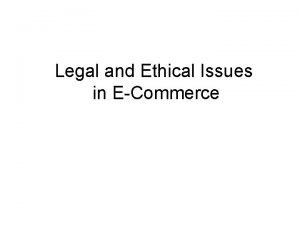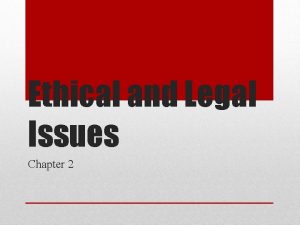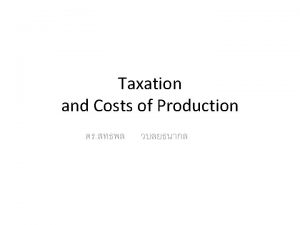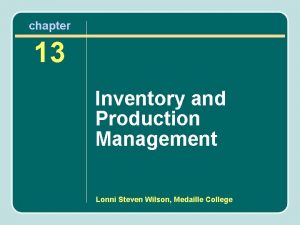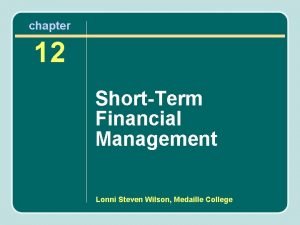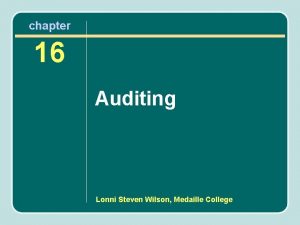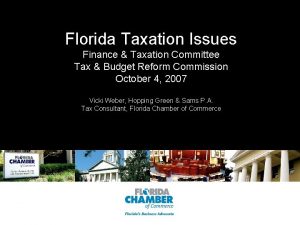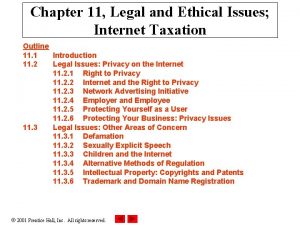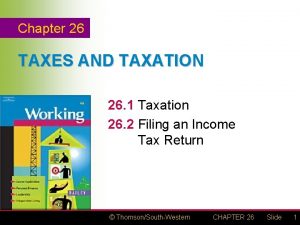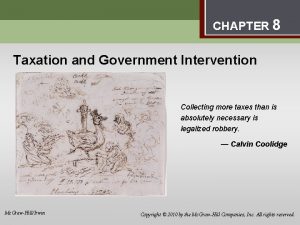chapter 14 Taxation and Legal Issues Lonni Steven




















- Slides: 20

chapter 14 Taxation and Legal Issues Lonni Steven Wilson, Medaille College

Key Chapter Objectives • Understand some of the tax concerns affecting the sport industry. • Describe the importance of tax planning in sport. • Understand how tax law is applied to athletes. • Understand the basics of financial risk management.

Taxes and Cash Flow • Tax basics: No matter what organizational structure is chosen for a business, every manager needs to know some tax basics. • Cash flow: Subject to taxation when disbursed and when received. • Tax rate affects investing decisions: If the tax rate on a given investment cash stream is too high, the investor will opt for a different investment that may have a lower return, but also lower taxes.

Tax Rates and Investment Decisions • Taxes of taxable investments may cancel out the benefits of the higher interest rates associated with them. – A $1, 000 tax-free bond that pays 5% per year results in $50 per year to the investor. – A $1, 000 face-value bond that pays 7% per year after the 30% tax rate the owner may have to pay (depending on the bracket the person falls into on personal income taxes) results in $70 (7%) $21 (30%) = $49. • This may be only a $1 difference, but the security of the tax -free bond (which is likely backed by a government entity) makes it a more solid investment.

Formulas for Investments and Taxes From the example on the previous slide, two formulas can help an investor determine which of two investment options would return the most after taxes: • Tax-equivalent yield • Minimum municipal bond yield

Tax-Equivalent Yield • This is the yield a taxable investment would have to produce to match a tax-free investment. • A formula measures the yield of a tax-free municipal bond against other investments that might require tax payments. • The formula is as follows: tax-equivalent yield = tax-exempt yield / (1 - tax rate). • If a business has a 28% tax rate, and a tax-exempt municipal bond pays 5% interest, the necessary return on a taxable investment would be 5% / (1 - 0. 28) = 6. 94%. • Thus, to maximize investment return, the business should invest in the tax-exempt municipal bond unless it can find another investment that has a return greater than 6. 94%.

Minimum Municipal Bond Yield • To determine the yield on a municipal bond (YM) when you know the taxable bond yield (TBY), use the formula YM = (TBY)(1 marginal tax rate). • For a person taxed at 31% who is considering a taxable bond with a 14. 5% return, YM = (14. 5%)(1 - 0. 31) = 10. 0%. • In other words, such a person would want to find a municipal bond with a rate of at least 10. 0% in order to match the yield of the taxable bond.

Key Terms value-added tax—A tax that is applied to the value added at every stage of the manufacturing process. marginal tax rate—The percentage of tax liability imposed on the next dollar of income earned by the company or individual (Spiro, 1996). average tax rate—The total tax liability imposed on all taxable income.

Significant Tax Issues in the Sport Industry Lease values (and amortization) Public tax dollars helping owners • Issuing of tax-exempt bonds to sports franchises (private owners) • The private-activity test (related to determining if a bond is tax exempt) – if less than 10% of a facility’s use is controlled by a private business or if 10% of revenues to repay the bonds are derived from the private use (continued)

Significant Tax Issues in the Sport Industry (continued) Bowl games and the taxation of educational (not-for-profit) institutions • Forcing nonprofit educational institutions such as schools involved in bowl games and some athletic departments to pay taxes if they are in fact engaged in a business enterprise • Some sponsorship money taxable

Tax Issues for Athletes How to categorize income • A professional athlete’s salary is subject to income tax withholdings. • But signing bonuses are not considered remuneration for services and generally are not subject to the employer’s withholding taxes. • However, the tax law clearly indicates that bonuses paid to baseball players that are predicated on continued employment are subject to withholding (Revenue Ruling, 1958). (continued)

Tax Issues for Athlete (continued) Business expenses for athletes • Game tickets for individuals who train the athlete to help improve the athlete’s skill • Expenses for operating a training camp or for off-season conditioning • Dues for a player’s association • Expenses for tax planning and investment advising • Agent fees • Fines imposed by a league or team for misconduct (Ray Robinson v. Commissioner, 1965) As the list suggests, careful planning by an athlete can reduce potential tax obligations. (continued)

Tax Issues for Athletes (continued) • It is important to recognize and appreciate that the failure to properly plan can destroy an athlete as easily as it can destroy a business. • Former Dallas Cowboy great Tony Dorsett became so involved in ill-advised tax shelters that by 1985 the IRS had taken his paychecks and put liens on his homes to satisfy a $414, 274 tax obligation (Rosenblatt, 1989).

Depreciation of Assets • Current expenses can be written off the year they are incurred. For example, the Stars spend $10, 000 on office supplies; those expenses can be utilized to decrease income earned that year and ultimately reduce the tax burden. • Capital assets are expensive assets that have a longer life (e. g. , machinery). For example, if a machine costs $1 million and has a life of five years, the company can depreciate it by $200, 000 a year for five years. (continued)

Depreciation of Assets (continued) • The salaries of athletes involved in professional sports are the only type of salaries that are depreciable (Euchner, 1993). • The owner of a professional franchise can claim depreciation for five years after purchasing a franchise. • In 1976, Congress passed the Tax Reform Act, which limited 50% of the franchise purchase price to players’ salaries.

Depreciable Assets of Sports Teams Players are not the only assets that can be depreciated by a professional team. Other capital assets that can be depreciated include the following: • The franchise itself • Lease contracts • Concession contracts • Broadcast contracts • Customer lists (Euchner, 1993) (continued)

Depreciable Assets of Sports Teams (continued) • The revenue stream available from luxury box lease contracts, concession contracts, and broadcast contracts can diminish over time. • Although these are income-earning assets, they can be depreciated, as with all other major capital assets. • In 2004 Congress passed a law allowing teams to deduct the entire franchise value over 15 years.

Financial Risk Management • Risk management is the process designed to identify problems and produce solutions for various risks that can range from tax concerns to litigationbased issues. – Designed for loss prevention • Insurance represents a finance technique termed risk transfer. • Risk financing – is designed to help settle a financial dispute after a loss has occurred and – establishes who will pay.

Risks Include Decreased Revenues • Lost rent if a subtenant does not pay the rent on time • Interruption in business services through theft or vandalism of company property • Interruption in the delivery of supplies (e. g. , when a power outage occurs) • A reduced amount recovered from accounts receivable when debtors do not pay their accounts on time (Williams et al. , 1995)

Questions for In-Class Discussion 1. Should professional team owners be allowed to depreciate players’ salaries? Take the pro or con side of this question. 2. Should the Mobil Cotton Bowl and Ohio State University have been subject to taxes for unrelated business income even though funds from the advertising efforts were utilized for educational activities? 3. Should athletes have to pay tax in states they play in but do not live in? 4. Should the heirs of team owners have to pay taxes if they inherit a team? If so, should they pay taxes on the value of the team when originally purchased or at the appreciated value? 5. What are the tax benefits, if any, of having a corporate status? 6. What is financial risk management, and how can it be used by a sport business?
 Difference between ethics and legality
Difference between ethics and legality Lonni wilson
Lonni wilson Emerging issues in taxation
Emerging issues in taxation Ethical and legal issues chapter 2
Ethical and legal issues chapter 2 Medical legal and ethical issues chapter 3
Medical legal and ethical issues chapter 3 Chapter 3 legal and ethical issues
Chapter 3 legal and ethical issues Legal and ethical issues chapter 5
Legal and ethical issues chapter 5 Medical legal and ethical issues chapter 3
Medical legal and ethical issues chapter 3 Chapter 6 legal and ethical issues
Chapter 6 legal and ethical issues Legal and ethical issues chapter 5
Legal and ethical issues chapter 5 Legal and ethical aspects of nursing chapter 3
Legal and ethical aspects of nursing chapter 3 Ethical and legal issues chapter 2
Ethical and legal issues chapter 2 Chapter 2 ethical and legal issues
Chapter 2 ethical and legal issues Chapter 5 legal and ethical responsibilities
Chapter 5 legal and ethical responsibilities Legal and ethical issues chapter 5
Legal and ethical issues chapter 5 Chapter 2 ethical and legal issues
Chapter 2 ethical and legal issues Chapter 6 legal and ethical issues
Chapter 6 legal and ethical issues Chapter 6 legal and ethical issues
Chapter 6 legal and ethical issues Medical legal and ethical issues chapter 3
Medical legal and ethical issues chapter 3 The writer properly quotes and cited sources in some places
The writer properly quotes and cited sources in some places Professional issues in information security
Professional issues in information security
